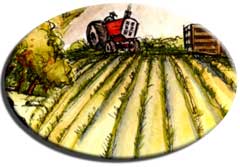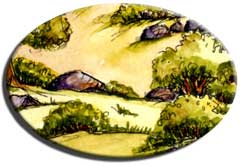Why is land use important?
Nearby Urban
| Explore an Urban Stream!* |
 |
Buildings, paved parking lots and roads are hard, impervious surfaces which control how water is transported to urban streams. In an urban setting, rain and snowmelt cannot penetrate the hard surfaces and soak into the ground. Instead, stormwater drains directly to storm drains, streams, or other surface water bodies. Typically the volume and velocity of surface water are higher in urban areas than in undeveloped areas. This can alter the natural drainage patterns and change the physical habitat of streams.
Often streams that flow through our cities and towns have lost many of the adjacent trees and shrubs that provide shade and streamside (riparian) habitat. The loss of riparian vegetation may increase water temperature above that which is healthy for fish and other native species that live in the streams.
Nearby Agriculture
| Explore an Agricultural Stream!* |
 |
Grazing cattle can eliminate riparian vegetation, trample steam bank and bottom habitat, and compact the soil, making it harder for rainfall to infiltrate soils and move into groundwater basins. Instead, more water flows directly into streams. Some natural drainages are channelized to provide water for irrigation or to move agricultural runoff away from fields. Increased flow volume and velocity can alter the natural drainage patterns and change the physical habitat of streams.
Other Uses
Explore a Natural Stream!*
California is endowed with magnificent natural landscapes. Redwood forests, deserts, chaparral are all signature California landscapes. Large areas within the state are relatively undisturbed when compared to the state’s cities, towns, and agricultural areas. These undeveloped areas are subject to fewer of the stresses we find in developed settings. The degree to which human activities influence stream health varies depending on the land use. Dirt roads that support timber harvesting can be a source of excessive fine sediment in our streams. Invasive plants may change the biological composition of native habitats. Mining activity can pollute streams. Careful land management can help preserve the health of these streams.
Some of the healthiest streams in California can be found in the Sierra and other remote areas. It is important for us to protect these special resources. See what’s being done to protect these and all our stream resources.
*Source of these stream diagrams
- Land Use Related stream diagrams from the US Geological Survey (USGS)
Please Note: some specific fish or aquatic insect species pictured & described here may not occur in California streams. - USGS Circular 1391, Published 2013 'The Quality of Our Nation's Waters Ecological Health in the Nation's Streams, 1993-2005 [Chapter 2, pages 30-35]'
How do we measure the influence of land use?
Land use is an important driver of stream health and land use type often correlates directly with stream condition. The Perennial Streams Assessment (PSA) looked at the relationship between the overall condition of our streams and nearby land uses.

